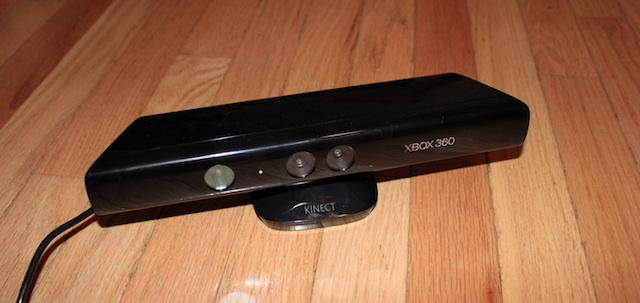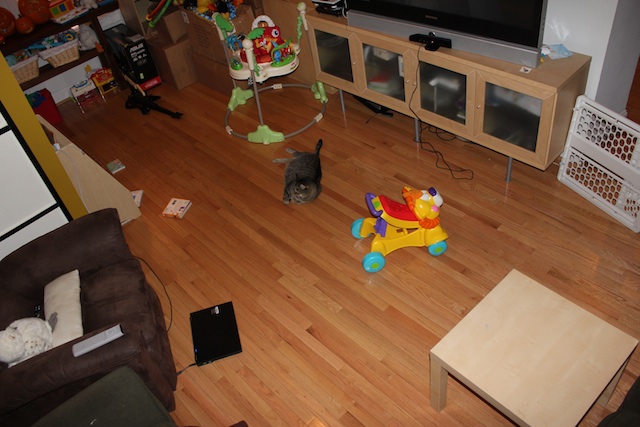I'm standing in front of my television, and as I lift both hands to the air, palms facing inward, the crowd goes wild. They stand and cheer. This is what it has come to: adulation for no effort. It's like I've just received a holy affirmation, and I'm ashamed to admit how good it feels. And this is just a menu in Kinect Sports. The Kinect whirrs to life when you turn your system on. It looks down at your floor, and then up to your face. It knows what your room looks like. My TV was on power-saving mode one night and came to life when I reached for a soda. The Kinect saw my arm movement and assumed I wanted to play. It's like a lost puppy.
My wife is uncomfortable with our television these days, as there are no less than three cameras or sensors facing us when we watch something; it's like facing a firing squad. The PlayStation Eye goes on the top of the television, the Wii sensor goes into a slot under the screen but above the base, and the weightier, mechanical Kinect goes on the TV stand. When the system is turned on there is a green LED that lights up on the front, as well as what appears to be a very weak red laser from the left-most sensor. That's the IR projector that the hardware uses to see in the dark. If Microsoft was right and I am the controller, I pray my system never becomes weaponized. Let's take a look at hardware that claims to be the future of our living rooms.
The hardware
Kinect isn't just a camera—it's way more advanced than that. The Kinect hardware sports a motorized base so it can move around to find you, and it adds depth sensors with an IR projector to the standard digital camera in order to see you clearly even without physical light. The hardware includes four microphones and an audio processor in order to isolate voices in different parts of the room and remove ambient noise.

Microsoft also touts the proprietary software and processing power that allows all of this to work. The Kinect has its own brain, and heats up considerably when in use (there is a vent on either side of the hardware). This computing power takes actual power; Microsoft had to create a new adapter that brings more juice to a USB-style connection, although that's only for the new, Slim systems. If you have an older system, you'll need to plug the Kinect into the wall as well as to a USB port on the back of your system.
Kinect also takes its toll on the 360 itself, as the console handles many of the computations needed to interact with your body in 3D space. You'll notice that the graphics on many of these games are simpler than what you're used to on the 360. There's a reason for that: adding Kinect support is going to require a few cycles to be used for motion controls instead of graphics. The team behind Forza told us their Kinect demo looked good because they were dealing with their own engine and were able to do a good amount of optimization. If a game's developer doesn't have that kind of time, money, or expertise with the engine they're using, expect see some graphical concessions.
While the Move is a combination of existing, simple technologies put together to do something interesting, the Kinect has been built from the ground up, and it includes technology and hardware that is more complex than many assume. That's both a strength and a weakness.
Connecting the Kinect
Installing the camera is a snap. As mentioned above, if you have one of the new slim 360s it's a single connection, but if you're using an older system you'll have to use a dongle with a USB connector for the 360, and a wall outlet for power.
The first time you attach the camera to your system you'll get a message warning you to make sure you have plenty of room, and to take breaks if you get tired. Good to know! Then you're warned to close out any games while an update is applied to your 360. This update took under two minutes to apply, so no sweat there.
The Kinect shows a green light when it's level and a red light when it's not. You'll want to install it 2 to 6 feet off the floor, on a stable surface. Next is the somewhat exasperating set of tests the system goes through before it begins functioning. The system checks background noise, and apparently the sound of a baby crawling around and me typing on my laptop are both okay. Then the TV plays a brief bit of music to test the sound levels when you're playing a game. It sounded fine to me at a comfortable level, but I was told my speaker volume was too low. I turned it up once, and it registered as fine. The microphone is then calibrated, and you're told to be vewwy, vewwy quiet while it sets itself up.
The system tells you to stand up, and then tells you to move into a green circle, using a generic Avatar to represent your movement. I moved into the circle, but just barely—my butt was still pressing into my easy chair. I waved at the system, it saw me, and I was calibrated. The whole thing takes a little under ten minutes. At this point I started to worry that my living room is too small.


reader comments
241